Related Research Articles
In chemistry, a salt is a chemical compound consisting of an ionic assembly of positively charged cations and negatively charged anions, which results in a compound with no net electric charge. A common example is table salt, with positively charged sodium ions and negatively charged chloride ions.

Weathering is the deterioration of rocks, soils and minerals through contact with water, atmospheric gases, sunlight, and biological organisms. Weathering occurs in situ, and so is distinct from erosion, which involves the transport of rocks and minerals by agents such as water, ice, snow, wind, waves and gravity.
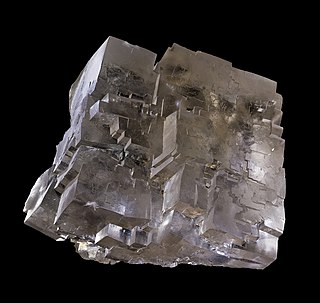
Sodium chloride, commonly known as table salt, is an ionic compound with the chemical formula NaCl, representing a 1:1 ratio of sodium and chloride ions. Sodium chloride is the salt most responsible for the salinity of seawater and of the extracellular fluid of many multicellular organisms. In its edible form, salt is commonly used as a condiment and food preservative. Large quantities of sodium chloride are used in many industrial processes, and it is a major source of sodium and chlorine compounds used as feedstocks for further chemical syntheses. Another major application of sodium chloride is deicing of roadways in sub-freezing weather.

An evaporite is a water-soluble sedimentary mineral deposit that results from concentration and crystallization by evaporation from an aqueous solution. There are two types of evaporite deposits: marine, which can also be described as ocean deposits, and non-marine, which are found in standing bodies of water such as lakes. Evaporites are considered sedimentary rocks and are formed by chemical sediments.

In chemistry, an ionic compound is a chemical compound composed of ions held together by electrostatic forces termed ionic bonding. The compound is neutral overall, but consists of positively charged ions called cations and negatively charged ions called anions. These can be simple ions such as the sodium (Na+) and chloride (Cl−) in sodium chloride, or polyatomic species such as the ammonium (NH+
4) and carbonate (CO2−
3) ions in ammonium carbonate. Individual ions within an ionic compound usually have multiple nearest neighbours, so are not considered to be part of molecules, but instead part of a continuous three-dimensional network. Ionic compounds usually form crystalline structures when solid.
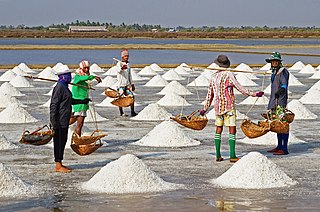
Sea salt is salt that is produced by the evaporation of seawater. It is used as a seasoning in foods, cooking, cosmetics and for preserving food. It is also called bay salt, solar salt, or simply salt. Like mined rock salt, production of sea salt has been dated to prehistoric times.

Kala namak or black salt is a kiln-fired rock salt with a sulphurous, pungent smell used in the Indian subcontinent. It is also known as "Himalayan black salt", Sulemani namak, bit noon, bire noon, bit loona, bit lobon, kala loon, sanchal, kala meeth, guma loon, or pada loon, and is manufactured from the salts mined in the regions surrounding the Himalayas.

Halite, commonly known as rock salt, is a type of salt, the mineral (natural) form of sodium chloride (NaCl). Halite forms isometric crystals. The mineral is typically colorless or white, but may also be light blue, dark blue, purple, pink, red, orange, yellow or gray depending on inclusion of other materials, impurities, and structural or isotopic abnormalities in the crystals. It commonly occurs with other evaporite deposit minerals such as several of the sulfates, halides, and borates. The name halite is derived from the Ancient Greek word for "salt", ἅλς (háls).

Crystallization is the process by which solid forms, where the atoms or molecules are highly organized into a structure known as a crystal. Some ways by which crystals form are precipitating from a solution, freezing, or more rarely deposition directly from a gas. Attributes of the resulting crystal depend largely on factors such as temperature, air pressure, and in the case of liquid crystals, time of fluid evaporation.

Water softening is the removal of calcium, magnesium, and certain other metal cations in hard water. The resulting soft water requires less soap for the same cleaning effort, as soap is not wasted bonding with calcium ions. Soft water also extends the lifetime of plumbing by reducing or eliminating scale build-up in pipes and fittings. Water softening is usually achieved using lime softening or ion-exchange resins but is increasingly being accomplished using nanofiltration or reverse osmosis membranes.
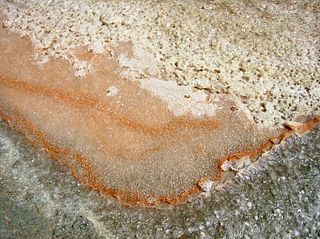
Fleur de sel or flor de sal is a salt that forms as a thin, delicate crust on the surface of seawater as it evaporates. Fleur de sel has been collected since ancient times, and was traditionally used as a purgative and salve. It is now used as a finishing salt to flavor and garnish food. The origin of the name is uncertain, but is perfectly in line with both meanings of fleur: the surface of something and its best part; the fact the salt crust also might form flower-like patterns of crystals might be of influence.
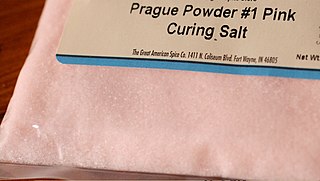
Curing salt is used in meat processing to generate a pinkish shade and to extend shelf life. It is both a color agent and a means to facilitate food preservation as it prevents or slows spoilage by bacteria or fungus. Curing salts are generally a mixture of sodium chloride and sodium nitrite, and are used for pickling meats as part of the process to make sausage or cured meat such as ham, bacon, pastrami, corned beef, etc. Though it has been suggested that the reason for using nitrite-containing curing salt is to prevent botulism, a 2018 study by the British Meat Producers Association determined that legally permitted levels of nitrite have no effect on the growth of the Clostridium botulinum bacteria that causes botulism, in line with the UK's Advisory Committee on the Microbiological Safety of Food opinion that nitrites are not required to prevent C. botulinum growth and extend shelf life..

Himalayan salt is rock salt (halite) mined from the Punjab region of Pakistan. The salt, which often has a pinkish tint due to trace minerals, is primarily used as a food additive to replace refined table salt, but is also used for cooking and food presentation, decorative lamps, and spa treatments. The product is often promoted with unsupported claims that it has health benefits.

Jugyeom, also known as bamboo salt, is a form of salt. It is prepared by packing bay salt in a thick bamboo stem, and baking it nine times on high temperature using pine firewood. During the baking processes, the impurities in the bay salts are claimed to be removed or neutralized while its inorganic contents, such as calcium, potassium, iron, copper, and zinc are increased.
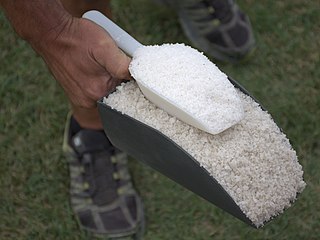
Sel gris is a coarse granular sea salt popularized by the French. Sel gris comes from the same solar evaporation salt pans as fleur de sel but is harvested differently; it is allowed to come into contact with the bottom of the salt pan before being raked, hence its gray color. Sel gris is coarser than fleur de sel but is also a moist salt, typically containing 13 percent residual moisture.

Mark Bitterman is an American entrepreneur and food writer. He is the owner of The Meadow, a boutique that specializes in finishing salts, bean-to-bar chocolate, cocktail bitters, and other products. The Meadow was founded in Portland, Oregon, in 2006, and has expanded to include three locations in Portland, one in Nolita in New York City, and one in Shinjuku, Tokyo. Bitterman began selling salt wholesale to award-winning restaurateurs in 2006, and in 2012 officially launched the Bitterman Salt Co. to sell salt through retailers nationally. Bitterman has published five books. Two are on traditional culinary salts and their use in cooking. Two are about cooking with Himalayan salt blocks, and helped pioneer the concept. His remaining book is on the use of bitters and amari in mixology and cooking. He consults with restaurateurs and lectures at culinary academies about the use of finishing salts and Himalayan salt blocks.

Salted: A Manifesto on the World's Most Essential Mineral, with Recipes is a reference book and cookbook written by food writer Mark Bitterman. In May 2011 Salted won the James Beard Foundation Award for Reference and Scholarship Cookbook. It has also been nominated for the International Association of Culinary Professionals Cookbook Awards for the Food & Beverage Reference/Technical category and First Book: The Julia Child Award. It is available both in hardcover and on the Kindle.

Dairy salt is a culinary salt product used in the preparation of butter and cheese products that serves to add flavor and act as a food preservative. Dairy salt can vary in terms of quality and purity, with purer varieties being the most desirable for use in foods. Dairy salt has been used since at least the 1890s in England and the United States. In butter preparation, it serves to retain moisture, while in cheeses, it tends to reduce water content and slow the ripening process.
Maldon Sea Salt is a salt-producing company in Maldon on the high-salinity banks of the River Blackwater in Essex, England. The river is favoured by flat tide-washed salt marshes and low rainfall.
References
- 1 2 3 Bitterman, Mark (2010). Salted: A Manifesto on the World's Most Essential Mineral, With Recipes. Ten Speed Press. pp. 67–68. ISBN 978-1-58008-262-4.